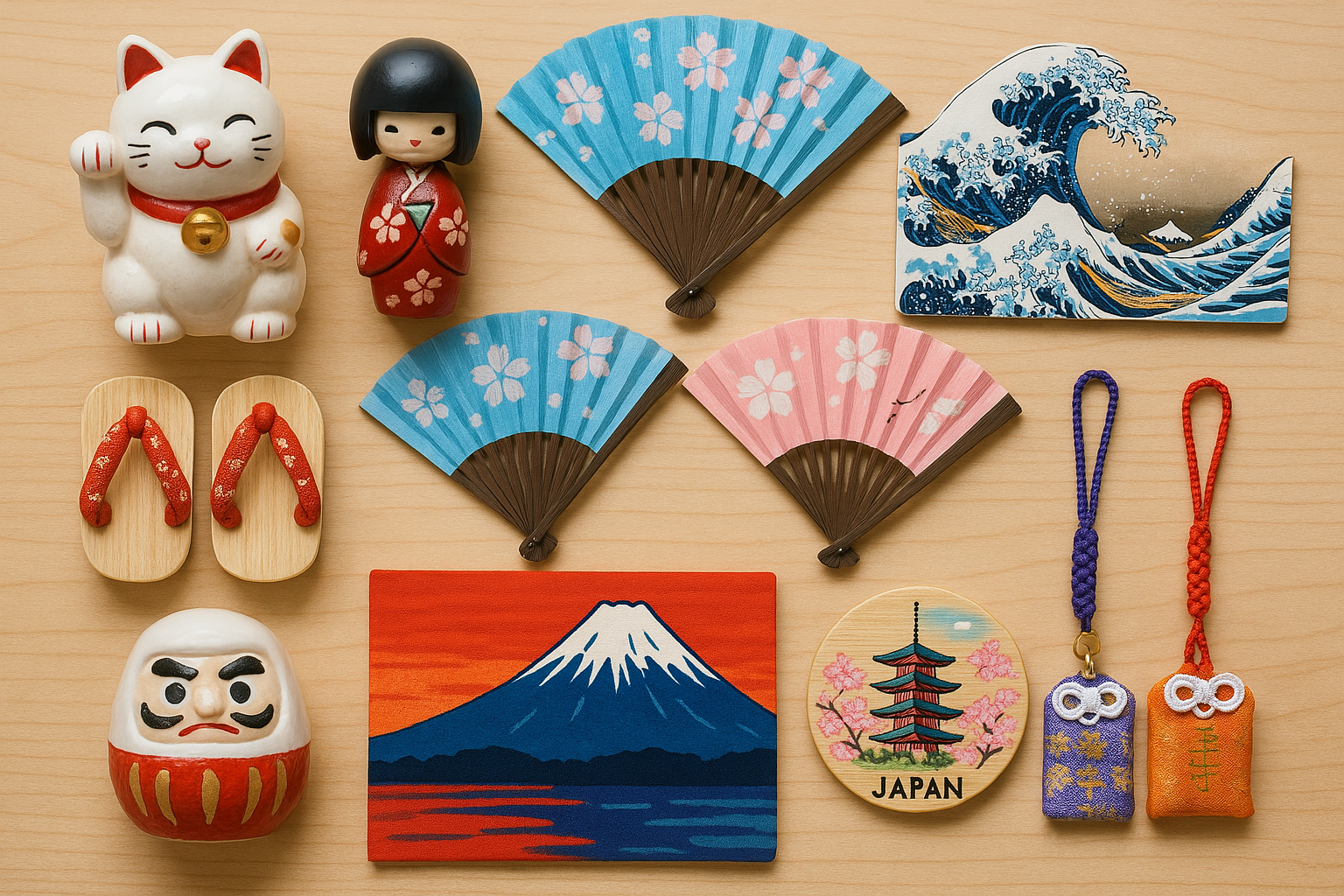- Introduction: Why Traditional Japanese Souvenirs Are a Must
- 1. Furoshiki: The Versatile Japanese Square Cloth
- 2. Japanese Tea Sets: A Piece of Japanese Serenity
- 3. Kokeshi Dolls: The Charming Wooden Figurines
- 4. Japanese Fans (Sensu and Uchiwa): A Cool and Elegant Souvenir
- 5. Japanese Pottery: A Legacy of Craftsmanship
- 6. Maneki Neko: The Lucky Cat Figurine
- 7. Samurai Swords: A Symbol of Japanese Honor
Introduction: Why Traditional Japanese Souvenirs Are a Must
When you think of souvenirs from Japan, what comes to mind? Maybe a colorful fan or a little maneki-neko (the lucky cat)? Traditional Japanese souvenirs are not just objects—they’re pieces of the country’s rich culture, history, and craftsmanship. Whether you’re wandering the bustling streets of Tokyo or exploring the serene temples of Kyoto, there’s something uniquely special about bringing home a little bit of Japan.
Souvenirs from Japan aren’t just about giving a gift; they are a way of connecting with the culture. They’re hand-crafted, thoughtful, and often have deep meanings attached to them. In this article, we’ll explore 12 of the most popular traditional Japanese souvenirs that you should add to your shopping list. These treasures will not only remind you of your time in Japan but will also make for great conversation starters back home!
1. Furoshiki: The Versatile Japanese Square Cloth
What is Furoshiki?
Imagine a scarf, but instead of just being worn around your neck, it can be used to wrap, carry, and even decorate. That’s furoshiki—a traditional Japanese square cloth with endless uses! It’s been around for centuries, originally used to wrap clothes or goods, especially in public baths where personal belongings needed to be kept safe.
Today, furoshiki is more than just a practical item; it’s a chic way to carry everything from your lunch to your shopping finds. They come in various sizes, colors, and patterns, with modern designs showcasing both traditional and contemporary Japanese art. It’s a great souvenir that blends fashion and function.
Its Origins and Versatility
Furoshiki’s history dates back to the Nara period (710-794) when it was used for wrapping and carrying things. Over time, the furoshiki evolved into an item that can wrap gifts, act as a bag, or even serve as a tablecloth. Imagine using one to pack your picnic for a cherry blossom viewing in the spring—how very Japanese!
How to Use a Furoshiki in Daily Life
The beauty of furoshiki lies in its versatility. You can fold it into a small pouch, tie it to create a bag, or use it to wrap a gift in an eco-friendly, stylish way. A furoshiki is also perfect for those looking to embrace sustainable living, as it can replace plastic bags and wrapping paper. With a furoshiki in your bag, you’re ready for anything—from shopping sprees to impromptu picnics!
2. Japanese Tea Sets: A Piece of Japanese Serenity
Types of Tea Sets
One of the most serene experiences in Japan is drinking tea. A traditional Japanese tea set is more than just a set of cups and a teapot—it’s a ceremony, a moment of mindfulness. You’ll find different types depending on what kind of tea you enjoy, whether it’s the delicate green tea (matcha) or calming black tea (sencha).
Traditional Ceramic vs. Porcelain Tea Sets
Japanese tea sets come in ceramic or porcelain, each offering a unique aesthetic and feel. Ceramic sets are perfect for the rustic, earthy vibe, while porcelain sets can be more refined and elegant, often featuring delicate floral patterns. Both types are popular in different regions of Japan, reflecting the local tea-drinking culture.
Notable Regional Differences in Tea Sets
The craftsmanship of tea sets varies across Japan’s regions. For instance, the famous Tokoname-yaki from Aichi Prefecture produces a distinctive reddish-brown ceramic that’s perfect for brewing green tea. Meanwhile, Kutani-yaki from Ishikawa Prefecture is known for its vibrant, intricate patterns. Wherever you are in Japan, a local tea set can make for a meaningful souvenir.
3. Kokeshi Dolls: The Charming Wooden Figurines
History and Meaning of Kokeshi Dolls
Kokeshi dolls are a symbol of simplicity and beauty in Japan. These handcrafted wooden dolls have been made for centuries, originally as toys for children in northern Japan. They are known for their smooth, round heads and simple bodies, typically dressed in brightly colored kimono.
How Kokeshi Dolls Are Made
Each kokeshi is hand-turned on a lathe, painted with a unique design, and often features facial expressions that exude charm and innocence. The dolls are made from wood like cherry or mizuki (Japanese lilac), giving them a soft, smooth texture. The craftsmanship is so intricate that each doll can take hours to perfect.
Symbolism and Cultural Significance
Kokeshi dolls have a deeper meaning than just being a cute souvenir. In Japanese culture, they are often thought to bring good fortune and happiness. Each doll is unique, with regional variations representing different traditional colors, patterns, and designs. When you buy a kokeshi, you’re not just buying a toy, but a piece of history and culture that has been passed down for generations.
4. Japanese Fans (Sensu and Uchiwa): A Cool and Elegant Souvenir
What Makes Japanese Fans Special?
Japanese fans are a must-have souvenir, especially in the hot summer months when they are used to stay cool during festivals or ceremonies. There are two main types of Japanese fans: sensu (folding fans) and uchiwa (flat fans). Both fans are works of art in themselves, hand-painted with beautiful designs ranging from floral patterns to traditional scenes from nature.
Hand-painted and Foldable Fans
Sensu fans are portable, foldable, and often beautifully painted with intricate designs. They’re a favorite during summer festivals and are perfect for hot days, keeping the air flowing on a warm afternoon. Uchiwa fans, on the other hand, are often used for decoration or as a gift, thanks to their large, flat surface that’s perfect for bold designs.
The Art of Crafting Sensu and Uchiwa Fans
The art of crafting these fans is centuries-old. The wooden spokes of the sensu are painstakingly folded into place, and the paper or silk is hand-painted with delicate designs. You can find fans that represent various aspects of Japanese culture, such as beautiful cherry blossoms, mythical creatures like dragons, or scenes from traditional kabuki theater.
5. Japanese Pottery: A Legacy of Craftsmanship
Understanding Japanese Pottery Styles
If there’s one thing Japan is famous for, it’s its pottery. Whether it’s rustic tea cups or elaborate vases, Japanese pottery reflects the country’s appreciation for craftsmanship and tradition. There are many styles of Japanese pottery, from the minimalist Raku ware to the colorful and detailed Kutani ware. Each piece is a functional work of art.
Famous Pottery Regions in Japan
Regions like Arita, Kutani, and Tokoname are known for producing some of the finest pottery in Japan. Tokoname ware, for example, is famous for its reddish-brown color and simple, yet sturdy design. Meanwhile, Arita pottery, known for its blue and white porcelain, has been crafted since the early 17th century. Wherever you are in Japan, there’s a pottery style that reflects the local culture.
Distinctive Features of Japanese Ceramics
Japanese ceramics often have a very organic feel to them. Many are hand-crafted, with each piece being one-of-a-kind. The pottery often features muted, earthy colors or delicate patterns inspired by nature. Buying Japanese pottery isn’t just about getting a souvenir—it’s about owning a piece of Japanese heritage.
6. Maneki Neko: The Lucky Cat Figurine
What Does the Maneki Neko Represent?
You’ve probably seen it before—those little cat figurines with one paw raised, often found in restaurants or shops. The maneki-neko, or “beckoning cat,” is a symbol of good luck and prosperity in Japan. It’s believed that the raised paw invites good fortune and customers to your business. In fact, you’ll find maneki-neko in almost every shop in Japan!
The Meaning of the Raised Paw
There’s a fun superstition behind the raised paw of the maneki-neko. A cat with its right paw raised supposedly brings in money and wealth, while a cat with its left paw raised invites customers and clients. Some even feature both paws raised, calling for all sorts of luck.
Origin and Cultural Significance
The maneki-neko originated in Japan during the Edo period and has been a beloved figure ever since. It’s often placed near the entrance of businesses to attract success and good fortune. The cat’s friendly and approachable look has made it a charming symbol that is recognized worldwide.
7. Samurai Swords: A Symbol of Japanese Honor
Understanding the Appeal of Samurai Swords
Samurai swords (katana) are some of the most iconic souvenirs you can buy in Japan. They symbolize the warrior spirit and honor of the samurai, a class of noble warriors who ruled Japan for centuries. These swords are not only practical weapons but works of art, with intricate designs and sharp, curved blades.
History of the Samurai Sword
The samurai sword is a symbol of the warrior class and was crafted with immense skill. The sword-making process is steeped in tradition, taking days or even weeks to complete a single sword. Some swords even feature intricate engravings and unique handles that tell the story of the maker and the samurai’s honor.
Authenticity and Craftsmanship
When buying a samurai sword, authenticity is key. Many shops sell replicas, which are more affordable, but true collectors will want to find an authentic, handcrafted katana. Look for reputable sellers who specialize in these pieces of Japanese history.







コメント